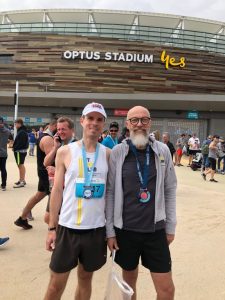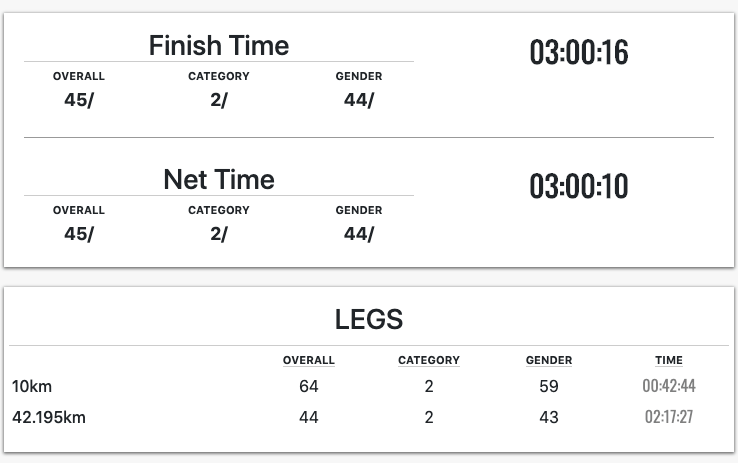By: Stephen McAlpine
2: 59:59 That was my goal anyway. My goal for the Perth Marathon. The magical, and elusive, sub three.
A sub three marathon while I’m still able. By “able” I mean realistically able at my age. I’m 52 now, and there’s a tipping point, a point of no-return for non-elite runners such as I to make that a realistic goal.
Was I able? Yes, I thought so. Last year at 51 years of age I ran a much tougher and hillier marathon in a fairly straightforward 3:08:20. Within two minutes of finishing that race I felt like I had more in the tank. I could have gone faster. I ran the day after that so obviously I didn’t over-do it in the race. I just wasn’t sure how under-done I had done it. I wanted to test that.
And now, lining up for my fifth marathon in two years I figured I was able. I’d stuck to my training schedule. I’d stayed injury free. I’d run the long runs slow and the recovery runs even slower. The intervals and speed sessions had just gotten faster as the weeks progressed. 1805km (1121 miles) in 18 weeks – the hay was in the barn.
Well not quite 1805km. You can subtract 42.2km from that. And that’s what it was all about. Everything had come down to that last 42.2km. That last 2.34 per cent of the program. Just 2.34 per cent left to run after 18 weeks. 97.66 per cent done. What’s a couple of lousy percentage points between drinks? A marathon, that’s what.
You see there’s something about that last 2.34 per cent. As I said, hay in the barn; the training is all done; the running conditions as I toed the line were perfect (6am, 9 degrees C, cloudy and a light breeze); I had had no injuries at all. But the main body part that needed to fire today was my brain.
All things being equal, by the time you’re standing six metres behind the priority start runners – the gazelles – waiting for the gun to go off, the marathon is won or lost in your head. Just keeping it together to run at a constant pace (4:12 minutes per km/6:45 per mile to stay on the safe side of a slightly longer course) was something I hadn’t achieved in the past.
Two of my four marathons had ended up with blow outs – the dreaded “hitting the wall” – with about ten kilometres to go. The self-loathing that kicks in, the sheer desire to stop, the monumental effort not to stop, when you hit the wall is legendary. And having been through that twice, it was the one fear in my head. There was no doubt about it for me, this was a mental race.
And this one was big for a local marathon. It had sold out weeks prior, as had the half marathon. And it was starting and finishing at Perth’s new Optus Stadium, recently crowned the best designed sports stadium in the world. Perth is a beautiful city and I run past the stadium most weekends, but to start and finish my goal race inside it, with a crowd gathered to watch would be special.
My plan was to stick with the official three-hour pacer, a local running legend/coach, Tony, who gathers friends and supporters as often as he gathers personal bests. He’d just come off a lazy 2:42 the weekend before at Berlin, jumped on a plane back to the Antipodes, sorted out the jet lag, and was fronting up to help others – including me – realise a running dream.

My coach Simon, a fellow church planter and seriously gifted runner, texted me from France the night before, where he was leading a run tour. He and his daughter were in the line at The Louvre to see the Mona Lisa, and he messaged me this:
‘My thoughts at this point: 1. You’re in great shape. Run in the shape you’re in and you’re going to have a great run. 2. Tony’s train is your ticket to good times 3. While it’s a good plan to just lock in and zone out on the sub-3 bus, I’d encourage you to move about in the pack every few km. But go with what’s working for you. 4. Run with endurance 5. Run with joy 6. Smile! Ps. You’re going to do great things!’
With blokes like Tony and Simon on board this thing could happen! Simon chucked in that “Smile!” cos he knows me all too well. The thing about running, as Simon observes, is this: like many things in our lives, running is a great servant and a terrible master. I had started running so that it would serve me as I did pastoral ministry work; sitting at desks drinking coffees, and reading books, and talking with people takes its toll. A sedentary life at my age would be a mental, physical and spiritual disaster. So I took up running.
But when running takes you up? There’s a point you cross – and I’ve crossed it a few times -, especially when failing to meet a goal, or dudding a race. Running has threatened to take mastery over me on many an occasion.
You see, we were built to serve. Bob Dylan says we gotta serve somebody. It may be the devil. It may be the Lord. Or it may be running. And it can enslave your mood, your hopes, your thoughts, your sense of worth.
And that’s not just for suburban old dads such as me. Australian Olympian Eloise Wellings, who heads up the aid development program Love Mercy Foundation, is a Christian, and a friend of Simon’s. She talks of the hidden problem among many young elite female runners who are starving themselves, and risking major injury, just to get that extra bit of speed. By the way, check out the foundation, spread the word, help them out by sponsoring their programs. They’re brilliant.
But back to the race. I pushed my way to the front and an arm went around me and I heard the words “Come on Stevie!”. Tony! Smiling as usual, he was wearing a pacing singlet and had a black helium filled balloon attached, so people could follow him. I wasn’t the only one on the sub-three train. There were about ten to fifteen or so of us, guys and girls, mostly youngish. Me way older than all of them, apart from Tony, who happens to be a freak of nature.
And now for the 2.34 per cent. The gun went off and the crowd swelled forward, our crew up near the front. Only 2 per cent of marathoners ever achieve a sub three hour, so you know there will be more behind you than in front. And with Tony’s help I was going to be part of that elusive couple of percentage points.
Straight away we fell into a steady pace. If such a thing exists, Tony is a marathon-whisperer. He can cajole and soothe a three hour time out of just about anyone who takes up the challenge. The key is how he starts. He’s a Goldilocks – not too fast out of the blocks so you don’t burn up early. Not too slow or you have to crank it up at the end when your lungs and legs are screaming. If Olympian Bruce Jenner was the 1970s face of Kelloggs Corn Flakes, Tony Smith is the 2019 face of Kelloggs Just Right.
You see here’s the thing. A steady pace at the start of a marathon feels so, so slow! What with all the training, a taper week that leaves you busting out of your skin, and all that adrenalin coursing through you, the first thing you want to do is scamper off down the road. And therein lies the danger. And the life lesson. There’s a reason we say life is a marathon and not a sprint. You will burn out early if you strain too hard.
So we were off. Just as I’d done four times before. But this time something had changed. This time once we’d settled in for a kilometre or so, I more or less zoned out for about thirty more. By that I mean I went into the most relaxed state I’ve ever been when running, where I pretty much disassociated from myself for three quarters of the race.
The spell was broken from time to time as Tony and the other three hour pacer directed traffic, gave shout outs to the spectators (a surprising large number who all seemed to know Tony), and called out instructions or warnings “Bollard!”, “Sharp right!”, “Drinks and gels on your left coming up!”.
But generally all I could hear – all I could make myself hear – was my very steady – too steady (?) breathing, not laboured, not panting, but steady. Tony was too experienced a runner to try and get into the chit-chat. That would just mess with our heads.
And all I could see – all I made myself see – was the rhythmic movement of legs and shoes directly in front of me. The ground looked like a huge treadmill, fit for fifteen people who were more or less running in the hope that no one got out of step or we’d all be on our faces.
I didn’t look at my watch. I didn’t look at the time splits. I didn’t look at the river, or the trees or the buildings. I zoned in on the road, raising my head and moving to the side only to grab a cup at the regular drinks station, before joining the pack again, and zoning in on that road, those shoes, that rhythm. Kilometre, after kilometre, broken only by the timing mats beeping as we crossed them for our time splits (and to ensure no one was cheating and hopping in to the race at a late stage from a side road).
Bang! Someone took a face plant. All it takes at that pace and in that state is a slight dip in the road, a slight turn not taken properly. A ripple of shock and a turn of the head. He was up again. He was alright. He was still running, even if his heart rate had spiked. And I’m sure we all felt that slight sense of complacency, ‘It wasn’t me.” It happened again too to another of us. But again, he was up and going. Our sense of camaraderie was thickening up as the kilometre markers ticked along. We each wanted this for the others as well.
I allowed myself to drift back and forward in the pack, almost subconsciously, to the point were it felt like we had a unified mind on how this would happen. That is until about the 30km mark, when I realised that the fifteen or so had dwindled. Dwindled quite rapidly. We were headed for the 32 – the dreaded 32 – where the wall was waiting. And suddenly there were only five or so of us. Two or three had surged forward, and would break the three, but the others were just slightly off the pack. It was Tony, the other pacer, me and one or two others sitting on the limit.
And I kept waiting for the wall. Waiting. Waiting. Waiting. 32km, 33km, 34km. No wall. By this time Tony was proving his worth. Prior to this he had given us very few instructions about how to run, but now that was all it was. And for good reason. By this stage the voices in our heads – or was it just in my head – were screeching at us that this was getting hard, this was going to break, this was going to crash and burn, this was starting to take its toll. And Tony’s voice over the top of all that was constant encouragement.
“It’s a hill! Shorten your stride, lift your head, don’t look down! Enjoy using a different muscle group!”
Enjoy? Enjoy?
“Look up and smile! It’s just two Parkruns to go! Take it in! You’ve trained for this!”
Tony used to be a British soldier who had done several tours in my home country, Northern Ireland, but he was as far from the leather-lung staff sergeant as you could get.
For even though the pain had kicked in, I realised I was enjoying it. I’d never run as fast for as far and still had something left in the tank. This time I felt like I was going to do it. And as I kept right on Tony’s heels right up to the 40km mark, lungs and legs screaming at me, that sense of fear about hitting the wall suddenly lost its grip.
But there was one concern. A little concern. But a concern nevertheless. The last ten kilometres wound around the river. It was less straightforward than the middle twenty or so, and we’d had to go up and over a bridge, and with three to go we had to navigate the bridge again, before a winding and lumpy last kilometre into the stadium. And just as we hit kilometre 41 we hit the path up the bridge.
It was just a small gap. A small distancing between Tony and me. But it was enough. It was enough to break the magic thread that tied me to him. And perhaps enough to break the magic spell in my brain, because I as strained up that bridge, the ground started to grab at my feet.
The bridge started to look like the Sydney Harbour Bridge. It suddenly felt hot and humid. I could hear myself gasping. I could hear myself going “Argh, come on, come on!” I hadn’t looked at my watch for over two hours and suddenly I was clock watching like a level two public servant on a Friday afternoon. And for one agonising kilometre my average split time dipped. Dipped enough for me to feel it. Yet there was nothing, absolutely nothing I could do about it.
I “arghed” and huffed and panted, lungs bursting out of my chest into the shadow of the stadium, Tony by now fifty metres in front of me, and I knew it was going to be touch and go. Knew it was up for grabs.
As I rounded the corner into that prize winning stadium and heard the cheers, I could see the clock, and as I ran down that straight I could see it tick over three hours. No prize for me! And as I landed on that last timing mat, stopping my watch almost subconsciously, I knew that I hadn’t quite made it. Hadn’t quite joined that elusive two percent of the marathon population with that final 2.34 percent of my program.
3:00:09. A personal best by more than eight minutes. 45th overall and second in my age category (who was that mysterious 50-something who beat me?), 44th male, beaten by the female winner, young mum, Kat Watt with steel in her spine, and grit beyond belief, who is fast becoming a local hero in running circles.
But what I wouldn’t give for those ten seconds! I tried to imagine the second here or there that I’d left out on the course at various arcane locations, but the reality was it was the last kilometre. Those ten seconds are strewn messily across that bridge and the winding pathway to the stadium. I’ll run by and pick up my rubbish some time.
The first arm around me, of course, was Tony, comforting and congratulating me at one and the same time. He’s made it across the line in 2:59:31. The boy could pace for Australia! And then as others from the pack finished behind me, we all started congratulating each other. And then as I grabbed my phone out of my race pack, the texts flowed in. Simon – tracking the race in the wee hours in France. Rob, a solid sub-three-man who has run thousands of kilometres at my side for several years.
And it sunk in at that point. I wasn’t devastated! I wasn’t devastated! A bit disappointed. But not devastated. I felt like I’d been promised a million dollars only to be given half a million. Running had served me well today. I had gone forwards, not backwards, in a number of ways. I gave it absolutely everything physically and mentally. Running had not become my master. And for that I was grateful.

Well I say I haven’t gone backwards. But it’s two days later. My quads are killing me. They refuse to cooperate. We have stairs in our house. The only way I can go down the stairs at the moment is backwards. I have gone backwards more times in the past two days than the time I started to crawl.
Everywhere I have gone these past two days there are stairs to negotiate. The shops. Church in the theatre on Sunday. The conference stage I spoke on this morning. If the quads don’t ease off soon the speedometer will go all Ferris Bueller and I’ll have done less kilometres by the end of the week than when I started it.

Article supplied with thanks to Stephen McAlpine
About the Author: Stephen has been reading, writing and reflecting ever since he can remember. He is the lead pastor of Providence Church Midland, and in his writing dabbles in a number of fields, notably theology and culture. Stephen and his family live in Perth’s eastern suburbs, where his wife Jill runs a clinical psychology practice.
